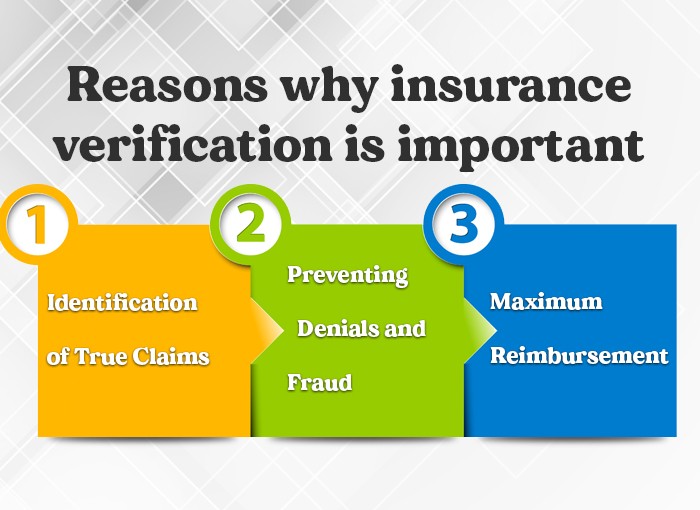Why is Insurance Verification Important
But insurance claims can easily be manipulated leading to denial or fraud. This makes it necessary for hospitals to verify claims of the insurance to be able to get payment for the medical resources spent on the patients.
Key Benefits of Insurance Verification
The following are the reasons why insurance verification is important:
Identification of True Claims
The healthcare industry encounters thousands of patients claiming to have healthcare insurance. However, not all of these patients succeed in submitting correct documents for their insurance claims. Insurance verification helps in identifying whether or not the insurance claim made by the patient stands true. The verification process is considered to be over only after the hospital has cross-checked the information given by the patient. For this purpose, the hospital is required to contact the insurance provider and get the information cross-checked. In other words, verification helps in establishing the eligibility of the patient for the insurance claim. Furthermore, it also helps in identifying the coverage status and active/inactive status of the claim.
Preventing Denials and Fraud
Insurance claims are required to be authorized by the insurance company. Without authorization, the payer is not obliged to make any payment. So, if you go to the insurance payer claiming to have insurance without any authorization then you won’t get the payment. In addition to this, not to forget, the EOB along with the insurance claim may also lead to the denial of the insurance. In such cases, insurance verification helps prevent denied claims as the verification process demands to review of the submitted documents. Moreover, verification also helps in preventing fraud by eliminating false insurance claims.
Maximum Reimbursement, Strong Revenue Cycle
Insurance verification ensures reimbursement of maximum insurance claims by getting them authorized, eliminating fraud, and preventing all the denied claims. This means hospitals and doctors get paid for the medical insurance verification services they have provided to the patients having insurance claims. The uninterrupted cash inflow ensures that the hospital can invest in different medical specialties by getting new medical equipment and expanding inpatient/outpatient facilities to improve the quality of medical care.
The Insurance Verification Process
1. Gathering Patient Information
The first step in insurance verification involves amassing accurate patient statistics. This consists of info like the patient’s complete name, date of birth, coverage ID range, and the name of the coverage company. Ensuring the accuracy of these details is essential for a clean verification manner.
2. Contacting the Insurance Provider
Once the affected person statistics are accrued, the next step is to touch the coverage enterprise. This can be carried out via online portals, phone calls, or automated systems. Providers verify whether the affected person’s coverage policy is lively and verify coverage information for the desired clinical services.
3. Confirming Benefits and Limitations
Effective insurance verification is a cornerstone of green sales cycle management. It ensures that every one billing and coding tactic are aligned with the affected person’s coverage coverage, minimizing errors and delays. This enables in maintaining a steady cash flow and financial stability for the healthcare facility. Understanding these elements allows in presenting accurate cost estimates to patients.
4. Documenting Verification Details
After confirming the insurance information, it’s miles vital to document all the info for future reference. This consists of the date and time of verification, the call of the insurance consultant, and the statistics provided. Proper documentation facilitates in resolving disputes and guarantees responsibility.
Challenges in Insurance Verification
1. Time-Consuming Process
Insurance verification can be a time-intensive undertaking, especially for practices with an excessive extent of patients. Staff contributors need to spend sizable time amassing and confirming details, that may effect productiveness.
2. Frequent Policy Changes
Insurance rules and insurance information can alternate frequently, making it challenging to hold up with the ultra-modern facts. Failure to stay up to date can result in mistakes and claim denials.
3. Lack of Automation
Many healthcare centers still depend on manual processes for insurance verification. This will increase the danger of human errors and makes the procedure much less efficient. Investing in computerized systems can streamline verification and decrease mistakes.
Best Practices for Effective Insurance Verification
1. Use Advanced Technology
Implementing automatic insurance verification equipment can save time and reduce errors. These gear combine with digital fitness records (EHR) and provide real-time updates on insurance coverage and blessings.
2. Train Staff Regularly
Providing ordinary education to staff individuals on coverage verification processes and policy updates guarantees accuracy and efficiency. Knowledgeable group of workers can handle the technique extra effectively, decreasing mistakes and enhancing patient pride.
3. Verify Insurance Before Every Visit
Insurance coverage can exchange among visits, so it’s important to confirm details before every appointment. This guarantees that the statistics is up to date and stops remaining-minute surprises.
The Impact of Neglecting Insurance Verification
Failing to prioritize coverage verification can lead to several bad results for healthcare companies and sufferers. These include:
- Increased Claim Denials: Errors in coverage data often result in denied claims, leading to behind-schedule payments and monetary losses.
- Patient Dissatisfaction: Patients may experience pissed off if they receive sudden payments due to inaccurate coverage statistics.
- Disrupted Cash Flow: Delays in reimbursements can impact the monetary balance of healthcare centers, making it hard to manipulate operational charges.
Conclusion
Insurance verification is a fundamental thing of healthcare administration that advantages both companies and sufferers. By making sure accurate and well-timed verification, providers can lessen claim denials, enhance patient delight, and improve revenue cycle control. Despite the demanding situations, adopting exceptional practices and leveraging advanced technology could make the technique extra green and powerful. Prioritizing coverage verification isn’t only a necessity but a strategic move closer to constructing an obvious and straightforward healthcare experience.




